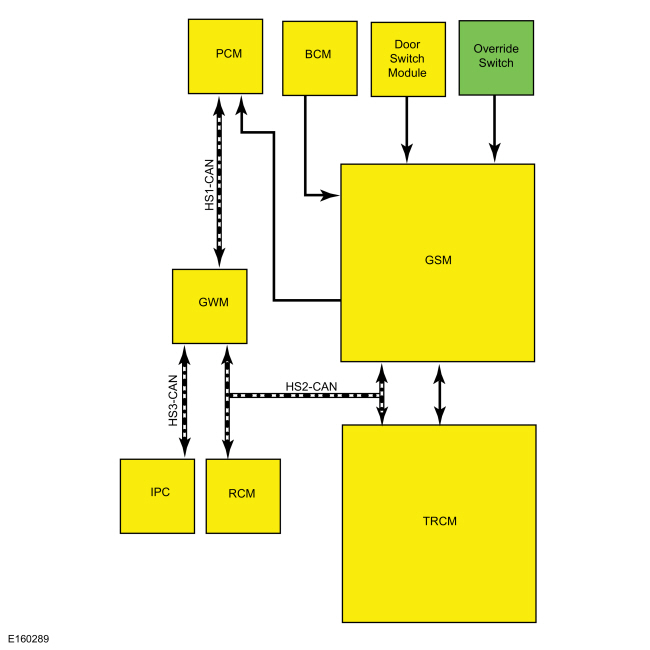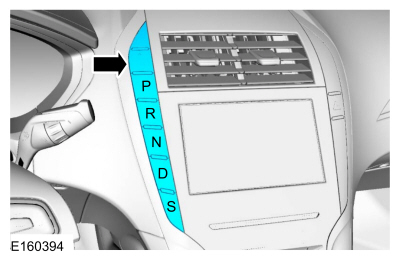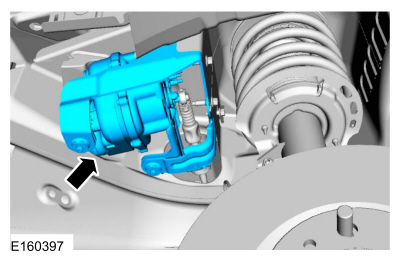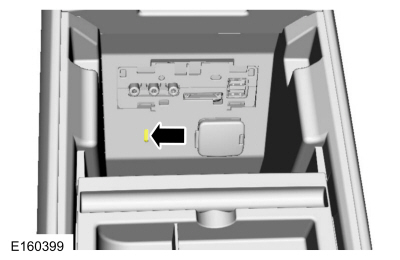| 307-05A Automatic Transmission External Controls - Vehicles With: 6-Speed Automatic Transmission - 6F50 | 2013 - 2014 MKZ |
| Description and Operation | Procedure revision date: 07/15/2013 |
System Diagram

System Operation
Normal System Operation
When the driver needs to change gear position the driver selects P R N D or S by pressing a GSM button. The GSM reads the switch inputs and sends a request to the PCM through a high speed CAN . The PCM receives the input from the GSM , combines in vehicle conditions to determine commanded transmission range then sends a command to the TRCM through a high speed CAN . The TRCM will act on the command from the PCM by moving the transmission to the commanded position via a selector lever shift cable. The PCM reads the transmission range sensor (TRS) and confirms the correct position has been achieved. The PCM then sends a message to the GSM and the IPC to display the current transmission range.
GSM
Each GSM button has three individual switch contacts that are used as input that the button has been pressed. If one switch contact is seen as non-functional the system will still work properly. However, if two switch contacts fail the button is no longer deemed reliable and a fault message is displayed. The park button is always honored under every circumstance with the following exceptions: The vehicle is in Neutral Tow Mode or the vehicle is moving (either forward or reverse) above 5 mph when park is requested. When park is selected above 5 mph neutral is provided along with a fault message in the IPC . The Brake Transmission Shift Interlock (BTSI) CAN signal is used for normal function to shift from P , however when the CAN signal is not available for Brake Transmission Shift Interlock (BTSI) from the BCM , a hardwire circuit from the brake switch as an input to the GSM is used.
RCM
The shift by wire system uses the driver’s seatbelt buckle as an input for automatic shifts to park when it is detected along with the driver’s door switch that the driver is leaving the vehicle. If the buckle is deemed faulted for any reason the system reads this as “unbuckled” so that any time the door unlock and latch switches are transitioned to “open” the TRCM will be commanded to return to park.
TRCM
The TRCM will not change gears unless it receives a command from either the PCM or the GSM . Under normal operation the PCM sends a command to shift. In direct mode the GSM sends the commands to shift. All commands are sent at the same time, but the TRCM ignores the direct mode command when the PCM is in control of the shift by wire system.
IPC
The IPC reads the position of the TRCM from the PCM and displays it. The GSM also displays this same signal from the PCM and uses it for its display as well.
BCM
The BCM provides a CAN signal for the Brake Transmission Shift Interlock (BTSI). There are three signals used to complete the Brake Transmission Shift Interlock (BTSI) signal: The ignition state, the transmission range sensor position and the brake pedal switch. Without Brake Transmission Shift Interlock (BTSI) signal the command to shift from Park is ignored and the vehicle is stuck in P . The Brake Transmission Shift Interlock (BTSI) Override may be used in this instance so that the vehicle is not stranded as long as the key fob is present and can be validated.
Default to Park
The TRCM has a spring actuated method to achieve P as a last resort if EPB is unavailable or system voltage drops out. When the vehicle system voltage is restored the TRCM will automatically relatch the spring. If the default to park is done with the vehicle running it will take a key cycle to initiate the relatch. Default to park will not initiate if the vehicle is already in P .
Return to Park
The vehicle has a safety feature that will automatically shift the transmission into P when one of the following conditions are met:
NOTE: The GSM defaults to sleep mode when the CAN is inactive for an extended period of time (2-15 minutes) and does not retain the driver door status information from before it went into sleep mode.
Stay in Neutral Mode
If necessary for the vehicle to stay in N without the driver present, such as being pulled through a car wash, this mode will disable Return to Park. In Stay in Neutral the system will remain awake draining the battery if the engine is off. The message Neutral Hold Engaged will appear on the information displays screen when the vehicle has entered Stay in Neutral. During this mode the N button on the GSM will flash continuously and the instrument cluster will display N as the selected gear. To disable the Stay in Neutral Mode, put the vehicle into gear.
Neutral Tow Mode
This mode allows the vehicle to power down in N , used to tow the vehicle long distances without draining the battery, this mode will disable Return to Park. To disable Neutral Tow, start the engine and press the brake, shift into position D and then into position R before shifting back into position N .
Cable Adjustment Mode
Using the scan tool, this mode enables the TRCM to shift to the D position and maintain that position during the selector lever cable adjustment procedure.
Brake Transmission Shift Interlock Override
This allows the shift by wire system to override the Brake Transmission Shift Interlock (BTSI) through a GSM override input through a Brake Transmission Shift Interlock (BTSI) override switch located in the floor console. If vehicle system has low voltage, this function will require the TRCM and GSM to be powered using an auxiliary power source. While pressing the Brake Transmission Shift Interlock (BTSI) override switch the vehicle will shift to N regardless of gear selection.
Component Description
GSM

The GSM receives inputs via buttons and communicates the driver requests for transmission gear position.
TRCM

The TRCM is an actuator that receives a command from the PCM and executes the proper gear position at the transmission via a selector lever cable. The TRCM has a pre-loaded spring and a capacitor and must not be disassembled.
Brake Transmission Shift Interlock (BTSI) Override Switch

The brake transmission shift interlock override switch is located in the floor console that when pressed will send an input message to the GSM to override the brake transmission shift interlock and allow the vehicle to shifted out of P . Both the TRCM and GSM need to be powered to override the brake transmission shift interlock.
Selector Lever Cable
The selector lever cable consists of:
Copyright © Ford Motor Company